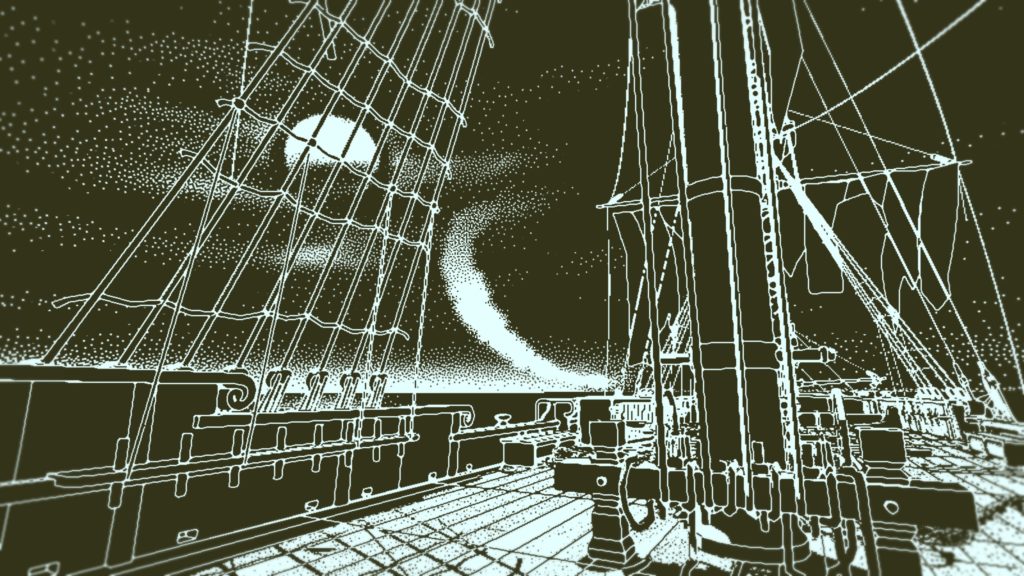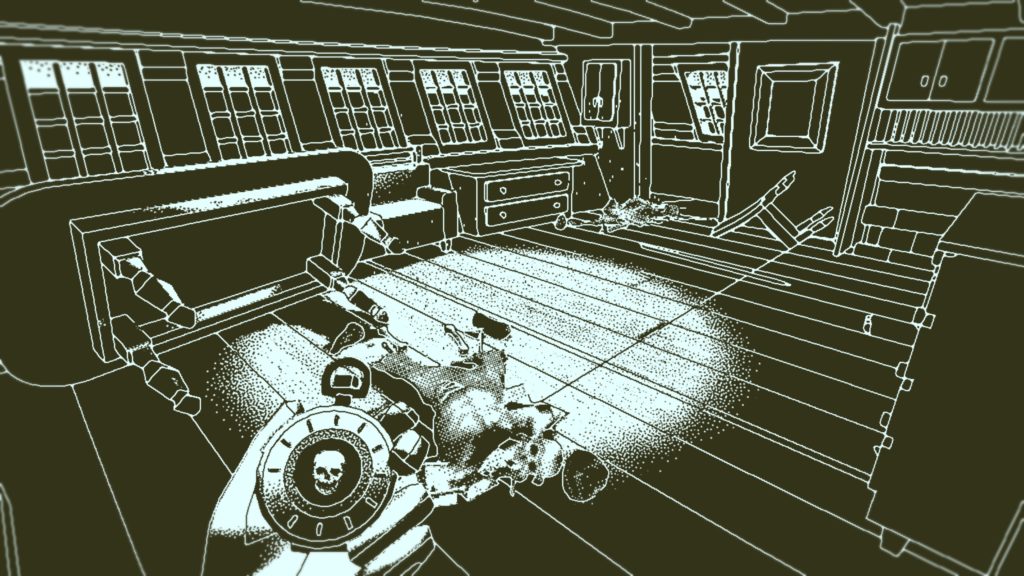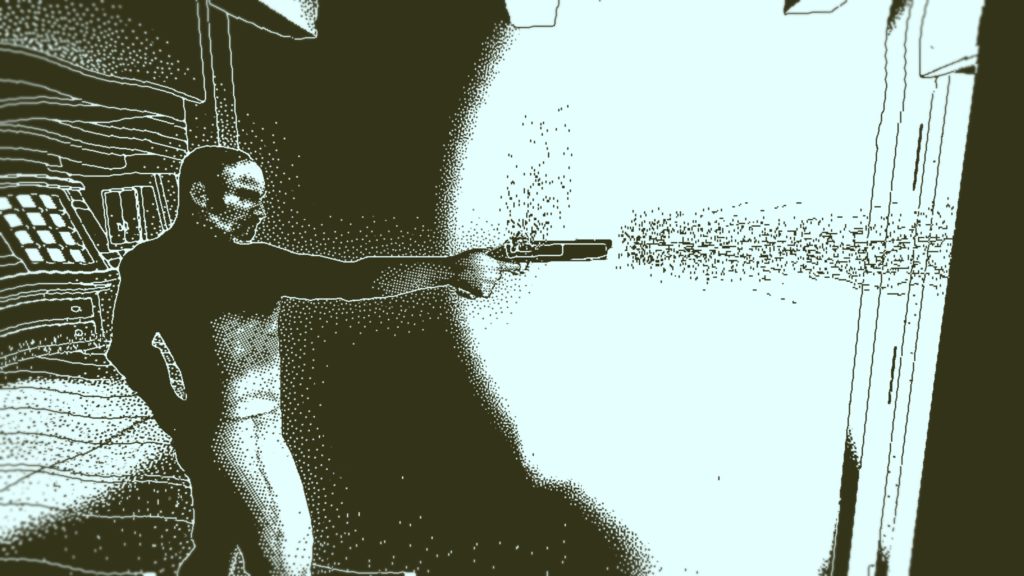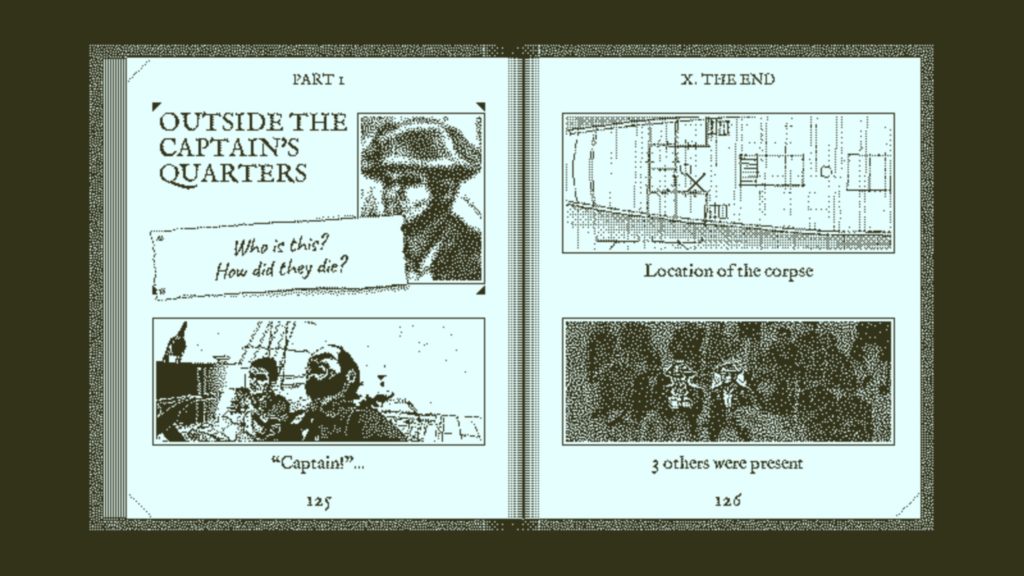Return of the Obra Dinn is a first person mystery game by Lucas Pope, the creator of “Papers, Please.” Five years after its departure for the Orient in 1802, the trade ship Obra Dinn drifts into port at Falmouth with no signs of life aboard. You are an insurance agent for the East India Company, tasked with boarding the ill-fated vessel and determining the extent of damages. Armed with a book containing the ship manifest and a mysterious pocketwatch that allows you to view the past, you must determine the fates of all 60 crew and passengers and piece together the story of the Obra Dinn.

Return of the Obra Dinn’s gameplay revolves around a magical pocketwatch that shows you the moment of someone’s death, provided you have a part of their corpse. You must wander the ship with the watch in search of the crew’s remains. When used on a body, the arcane instrument will transport you into a memory sequence, which begins with a dark screen and a short snippet of audio, sometimes including dialogue. Then you will enter a detailed still-life scene that shows the instant of the victim’s death. For a game about discovering the fates of 60 people, figuring out how each victim died is surprisingly often the easiest part, and the game gives you quite a few options to choose from–ranging from mundane things like accidents, knives, and guns to more supernatural threats. The really difficult part is determining who it was that died (or did the killing). This difficulty is compounded by the game’s lack of hints; Return of the Obra Dinn refuses to hold your hand.

Fortunately, you have received a book containing sketches of the crew and passengers as well as the ship’s manifest. Once you uncover a memory, a page will be filled out with the victim’s portrait, a card in which to record their identity and fate, a map with the corpse’s location, and sketches of the other people present. You will have to use all your skills of observation to determine the identities of the 60 souls aboard the Obra Dinn, taking note of their environment, activities, locations, clothing, languages, and accents to match them with the information in the ship’s manifest. It’s surprisingly easy to overlook simple clues, such as the fact that the ship’s carpenter will probably be found in at least one memory sawing away in the carpenter’s office, or that the captain will probably have the biggest hat in the sketches. You will also have to follow what the characters say, since clues are sometimes given out in the dialogue that precedes memories. Perhaps a character will call the victim by their name (a rare occurrence) or some other hint will be given as to the victim’s (or someone else’s) nationality, job, or name.

Once you make an educated guess about a victim, you must record their identity and fate in the book. You can always change it later if new information surfaces. For each three fates you record correctly, the book will notify you and lock them in place. The three-fates rule is a catch to prevent you from guessing at random until you get one right. And to further prevent you from trying brute force or process of elimination, two fates are locked until you solve all the others. Fortunately, these limitations seldom seem too horribly difficult, even with the lack of hints.

Return of the Obra Dinn wants you to figure everything out on your own, and it generally pushes you in that direction pretty well. It may be a little frustrating at times wandering around the ship to revisit memories or scratching your head over a few identities you’re not quite sure about, but the thrill of finally piecing everything together without relying on anything but your own mental prowess and powers of observation makes up for it entirely. And though some characters disappear and their deaths have to be guessed, their fates not explicitly shown, the game usually does a brilliant job giving you just enough information do get the job done and leave you feeling pretty satisfied about doing it.

All of this takes place in a wonderfully designed two-tone aesthetic that mimics classic computers. There’s high contrast between light and dark areas, and the game conveys shading and texture with well-placed dots of color. One might think a game about solving 60 deaths would benefit from high-resolution character designs and more than two colors, yet Return of the Obra Dinn does an outstanding job delivering unique and recognizable character designs despite that handicap. It is the near-perfect example of minimalist art style with wonderfully clever puzzle design. There are many small design touches that make Return of the Obra Dinn a deep and unique experience. The extremely unique visual design adds a level of character and interest that would be missing if Obra Dinn were a full color game.

In my 7-hour playthrough of Obra Dinn, I had high points of grand discovery and low points of dead-end frustration. Yet a path always opened, new clues presented themselves to me, and all the pieces fell into place at the last. Those seven hours were well worth my time and frustration, and I greatly enjoyed this game. If mystery or puzzle games interest you, Obra Dinn is definitely a game to look into, and I would recommend it wholeheartedly.
The Verdict:
The Game Factor: Is it fun? 8/10. Rare pockets of tedium, but success made it worth it!
The Look Factor: Is the Style or Graphics good? 10/10. So unique it deserves a 10!
The “Jump-In” Factor: Is the game easy to learn/hard to master? 9/10. Intuitive and easy to catch on to.
The Total Score: 9/10. Very unique, challenging puzzle narrative game that will keep you coming back for more!
Written by Cuthalion42
Want to better understand how we rate games? Check out OUR RATING SYSTEM
Find us on Facebook: @atechgames
Come play with us as we raise money for kids at GAMERS FOR KIDS
Check out our live gaming stream: ATECHLIVE.COM
As always, we welcome your questions and comments. Feel free to contact us: HERE

